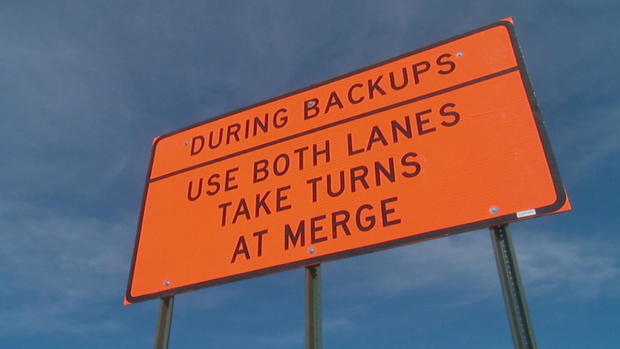Will the "zipper merge" help traffic flow on the roads?
We’ve all been there: you merge far in advance, just like you learned in driver’s ed, only to watch as the driver who was behind you speeds to the front of the line.
Turns out that person might have the right idea, reports CBS News correspondent Kris Van Cleave.
When cars line up in one lane, all the empty pavement on the other side is just sitting there, unused. Now some traffic engineers are saying: go use that space.
“So it’s OK to cut?” Van Cleave asked Kansas Department of Transportation traffic engineer Kristi Ericksen.
“It’s OK to take turns,” Ericksen said.
Kansas is one of at least eight states which have encouraged drivers to use what’s known as the “zipper merge” system. State transportation officials have put up signs asking drivers to use both lanes and take turns near a bridge construction project outside Kansas City.
What KDOT’s finding does is bring predictability to the commute. They know that it takes five to six minutes to get through the work zone even in peak traffic. From the air, you can see the cars keep moving and they come together like the teeth of a zipper.
One of the big challenges has been re-training drivers who were used to merging early. States have gotten creative to explain how lining up ahead of time can actually increase the backup.
Several studies point to benefits of late or zipper merging, including up to 50 percent shorter lines, a reduction in speeds around construction workers, and drivers reporting less anxiety and frustration.
But transportation officials in other states aren’t entirely convinced.
“We understand it’s about convenience in some other areas, but here in California, we’re all about safety,” Caltrans spokesman Mark Dinger said.
Dinger said his state continues to encourage drivers to merge early.
“We don’t want those people to cut in at the very last second. Not only can it lead to road rage incidents but again, it can lead to sudden braking which can cause a direct collision,” Dinger said.
KDOT’s Ericksen, however, can see a day where the zipper merge becomes the norm.
“It’s not something that we’re going to have to sign and teach forever. It’s just kind of one of those things that will come along as our cities grow,” Ericksen said.
That comes as welcome news to motorists who are no longer considered the “bad driver” on the road for merging later.
Engineers say the zipper merge only works in high-traffic, low-speeds situations. If it’s a work zone where you’re traveling closer to freeway speeds, experts say it is still better to merge early and safely.

